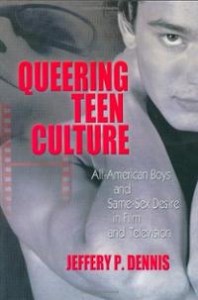 Queering Teen Culture: All-American Boys and
Queering Teen Culture: All-American Boys and
Same-Sex Desire in Film and Television
Jeffery P. Dennis
Harrington Park Press. 221 pages, $34.95 (paper, $16.95)
IF THIS BOOK is any evidence, Jeffery Dennis one of those people who can pepper conversations with references to Fabian, Frankie Avalon, and Foucault with equal ease. In Queering Teen Culture, Dennis traces the representation of male same-sex desire from the anxiety-ladened post-World War II family sitcoms all the way to the open (though not always satisfying) depiction of homosexuality in the teen comedies and dramas of today. Along the way, he also examines the spectacle of teen sexuality in the on-screen portrayal of juvenile delinquents, beach blanket buddies, androgynous teen idols, and what he refers to as “the rigidly homophobic Brat Pack.”
Dennis largely excludes lesbian teens from his analysis, which may seem odd for a study of how film and television engage in the “heteronormative policing” of same-sex desire in young people. He argues that the whole concept of the “teenager” was essentially a male category in postwar America, complete with particular socioeconomic tensions and demands—for example, that one defer adulthood until after college—which applied to boys but not girls. But the gap in expectations for boys and girls has narrowed in the decades since the 1950’s, thus diminishing the value of such a limited definition of “teen,” as Dennis moves through later generations. The author provides a thorough analysis of how postwar television represents both excessive interest in and indifference to girls (in favor of hanging out with male friends) as a cause for parental concern. For example, Ozzie and Harriet’s Ricky Nelson (the character, not the actor) disturbed his parents both when he demonstrated a precocious interest in girls and when he later didn’t care enough about dating.
The book’s preface and first chapter provide a brief introduction to the theoretical framework for the arguments to follow, from gender studies theories to pronouncements about how texts arrive at meaning within the cultures that produce and receive them. But it is difficult to identify Dennis’ presumed audience. Academic readers won’t need the many citations of well-known theorists and basic critical principles and assumptions, but the theoretical overview isn’t complete enough for readers who don’t already have a familiarity with the standard graduate humanities and social science syllabi of the last couple of decades.
Twentieth-century critical and cultural theorists, from Sigmund Freud to Rene Girard to Julia Kriseva, among others, have contributed much our understanding of the nature and function of desire. Its pervasiveness and the emergence of the term as a staple of the critical lexicon are all the more reason for us to strive for clarity when we talk about it. Much of the trouble with Dennis’ arguments lies in a lack of clarity about what he means when he talks about desire. He says it can arrive “in the form of buddies who rescue each other from the bad guy, same-sex friendships framed according to the generic rules of romance, whispered words, looks that ‘don’t lie’.” But these manifestations of desire aren’t always manifestations of the same type (or, if you prefer, structure) of desire. Sometimes, a guy just doesn’t want the bad guy to kill his friend. Simply characterizing all of these examples as “desire” doesn’t allow for important differences between intimate desires without sexual potential; those with sexual potential that neither partner wishes to realize; and those with sexual potential that only one wishes to realize. (And then there are, among other varieties, the many gradients of unreciprocated desire.)
As Dennis capably demonstrates in so many instances, teenage male friendships on the screen (as in life) can be confusing in both the direction and nature of their intimacies. But as long as we look to intense male intimacy as arising from a “desire” whose possible terms we cannot or will not name we only encourage men—gay, bisexual, and straight—to hold back in their expressions of it.
____________________________________________________________________
Thomas March, a poet and critic based in New York City, has appeared recently in 88, The Believer, New Letters, and Shenandoah.





